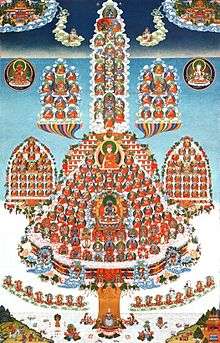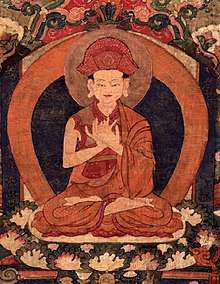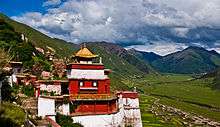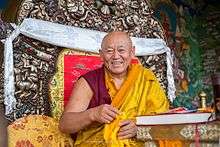Drikung Kagyu
Drikung Kagyu or Drigung Kagyu (Wylie: 'bri-gung bka'-brgyud) is one of the eight "minor" lineages of the Kagyu school of Tibetan Buddhism. "Major" here refers to those Kagyu lineages founded by the immediate disciples of Gampopa (1079-1153) while "minor" refers to all the lineages founded by disciples of Gampopa's main disciple, Phagmo Drupa (1110-1170). One of these disciples, Jigten Sumgön (1143-1217), is the founder of Drikung.

History


Like with all other Kagyu lineages, origins of Drikung Kagyu can be traced back to the Great Indian Master Tilopa who passed on his teachings to Mahasiddha Naropa who lived around 10th and 11th century. The founder of the Drikung Kagyu lineage was Jigten Sumgön (1143-1217) of the Kyura clan,[1] who was the disciple of Phagmo Drupa. According to historical account from the time, Jigten Sumgön's teachings attracted more than 100,000 people at a time, with the highest number of attendance recorded at 130,000.[2]
Several sub-schools branched off from the Drikung Kagyu including the Lhapa or Lhanangpa Kagyu, founded by Nö Lhanangpa (Wylie: gnyos lha nang pa , 1164–1224) who came to Bhutan in 1194. This school was at one time important in Western Bhutan, particularly in the Thimphu and Paro regions, where they were rivals of the Drukpa Kagyu. The Lhapa first came into conflict with the early Drukpa teacher, Phajo Drugom Zhigpo (b. 12th century)[3] and finally with Ngawang Namgyal (1594–1651). In 1640 the remaining followers of the Lhapa Kagyu were expelled from Bhutan together with the Nenyingpa followers as both had sided with the attacking Tsangpa forces against the Drukpa during their three invasions of Bhutan and continued to refuse to acknowledge the authority of the Shabdrung.[4]
Teaching and practice
The unique doctrines of Drikung Kagyu as taught by its founder, Jigten Sumgön is preserved in "The Single Intention" or "One thought of Drikung" (Drikung Gonchik, Wylie: dgongs gcig)[5] and "The Essence of Mahāyāna Teachings" (Wylie: theg chen bstan pa'i snying po). According to Jampa MacKenzie Stewart, the Gonchik "recasts Buddhism in a fascinating and innovative form, emphasizing each aspect as being capable of revealing the full process of enlightenment."[6]
The main practices of Drikung Kagyu are “The Five-fold Profound Path of Mahamudrā,” and “The Six Dharmas of Nāropa.” The five-fold Mahamudrā, also known as the "possessing five", consists of five elements:[7]
- Setting the motivation, arousing bodhichitta,
- Deity yoga, generating the Yidam. The main deity in Drikung is Chakrasamvara (in union with consort Vajravarahi), but Milarepa taught this method by using Chenrezig.
- Guru yoga
- Mahamudrā meditation (Samatha and Vipasyana)
- Dedication of merit.
This practice is traditionally cultivated in retreat alongside the Six Dharmas of Naropa, and it is preceded by the preliminary practices called ngondro.[8]
This presentation is outlined in Clarifying the Jewel Rosary of the Profound Five-Fold Path by Kunga Rinchen, the Dharma heir to Jigten Sumgön.
The Drikung Kagyu also have a tradition of Dzogchen teachings, the Yangzab Dzogchen.[9] It is based on termas revealed by the Drikung Tertön (hidden treasure revealer), Rinchen Phuntsog in the sixteenth century.
Phowa
The Drikung lineage is popularly known for its development of the practice of Phowa, in which a practitioner learns how to expel his/her consciousness or mindstream through the posterior fontanelle at the top of the skull at the moment of death. One of the Six Yogas of Naropa, this practice is said to aid the practitioner in remaining aware through the death experience, thus aiding one in attaining enlightenment in the Bardo (the state in between death and the next rebirth) or in achieving a birth conducive to the practice of Dharma.
Monasteries and centers

The first and main Drikung Kagyu monastery is Drikung Thil Monastery,[10] founded in 1179[10] by Jigten Sumgön[10] approximately 150 kilometers northeast of Lhasa.
Aside from the Drikung Valley in Ü, the Drikung Kagyu has a strong presence in Nangqên County in what was Kham, in western Tibet (including Kailash), and in Ladakh. Tsari and Lapchi - two important sacred sites for all Tibetan Buddhists - also have a strong Drikung Kagyu presence. Among the so-called "four major and eight minor" Kagyu lineages, Drikung Kagyu is one of four Kagyu lineages that continue to exist as independent institutions (the other three being the Karma Kagyu, Drukpa Lineage and Taklung Kagyu).
Outside of Tibet, the headquarters for the tradition in exile is Jangchubling, located in Dhera Dun, in the Indian state of Uttarakhand.[11]
Drikung Kagyu is one of the most prominent lineages in Ladakh where its main monasteries are Phyang and Lamayuru, with roughly 50 other monasteries spread across Ladakh region.
A series of Drikung Dharma centers were also founded in the West, a project begun by Drikung Kyabgon Chetsang Rinpoche in 1978.[12]
Lineage notes
Spiritual heads

| Part of a series on |
| Tibetan Buddhism |
|---|
 |
|
|
|
Practices and attainment |
|
Institutional roles |
|
History and overview |
From the founding of Drikung Thil Monastery in 1179 to the present day, the Drikung Kagyu lineage has been led by a succession of spiritual heads ("throne-holders"). One of the two current heads of the lineage, Drikung Kyabgön Chetsang Rinpoche,[13][14] Könchok Tenzin Kunzang Thinley Lhundrup (b. 1946),[15] the 37th Drikungpa resides at Drikung Kagyu Institute at Dehra Dun, India.[14] The other head of the Drikung Kagyu Lineage, the 36th Drikungpa, Drikung Kyabgön Chungtsang Rinpoche, Könchok Tenzin Chökyi Nangwa (b. 1942) lives in Lhasa, Tibet.[16]
Female protector
Another unique feature of the Drikung lineage is its female dharmapāla, Achi Chokyi Drolma. The great-grandmother of Jigten Sumgön,[17] she prophesied his birth and vowed to protect those in his lineage. She is unusual in that she is both a female protector and an enlightened bodhisattva that can be taken as an iṣṭadevatā in meditation practice. She is depicted either sitting on a horse or standing with a kapala in her left hand and a mirror in her right hand.[18] Achi's practice became so popular that she has been included in other lineages, such as the Karma Kagyu.
First nun
In 2002 Khenmo Drolma, an American woman, became the first bhikkhuni (a fully ordained Buddhist nun) in the Drikung Kagyu lineage. She is also the first westerner, male or female, to be installed as an abbot in the Drikung Kagyu lineage, having been installed as the abbot of the Vajra Dakini Nunnery (America's first Tibetan Buddhist nunnery, located in Vermont) in 2004.[19]
Drikung Kagyu lineage timeline
| Name | Date of Birth | Date of Death | Year Lineage Holding Begun | Year Lineage Holding Relinquished |
|---|---|---|---|---|
| Phagmodrupa | 1110 | 1170 | ||
| Lord Jigten Sumgon | 1143 | 1217 | 1179 | 1217 |
| Kenchen Gurawa Tsultrim Dorje | 1154 | 1221 | 1217 | 1221 |
| On Rinpoche Sonam Drakpa | 1187 | 1234 | 1221 | 1234 |
| Chen-nga Rinpoche Drakpa Jungne | 1175 | 1255 | 1234 | 1255 |
| Telo Dorje Drakpa | 1210 | 1278 | 1255 | 1278 |
| Thog-khawa Rinchen Senge | 1226 | 1284 | 1278 | 1284 |
| Chen-nga tsamchedpa Drakpa Sonam | 1238 | 1286 | 1284 | 1286 |
| Dorje Yeshe | 1223 | 1293 | 1286 | 1293 |
| Chu-nyipa Dorje Rinchen | 1278 | 1314 | 1293 | 1314 |
| Nyer-gyepa Dorje Gyalpo | 1283 | 1350 | 1314 | 1350 |
| Nyermyipa Chökyi Gyalpo | 1335 | 1407 | 1350 | 1395 |
| Shenyen Dondrup Gyalpo | 1369 | 1427 | 1395 | 1427 |
| Dakpo Wang | 1395 | [20] | 1427 | 1428 |
| Chogyal Rinchen Pal Zangpo | 1421 | 1469 | 1428 | 1469 |
| Rinchen Chökyi Gyaltsen | 1449 | 1484 | 1469 | 1484 |
| Gyalwang Kunga Rinchen | 1475 | 1527 | 1484 | 1527 |
| Gyalwang Rinchen Phuntsok | 1509 | 1557 | 1527 | 1534 |
| Rinchen Namgyal Chodak Gyaltsen | 1527 | 1570 | 1565 | 1570 |
| Chokyi Namgyal | 1557 | 1579 | 1570 | 1579 |
| Tsungme Chogyal Phuntsok | 1547 | 1602 | 1579 | 1602 |
| Naro Nyipa Tashi Phuntsok | 1574 | 1628 | 1602 | 1615 |
| Jetsǖn Könchog Rinchen (1st Chetsang) [21] | 1580 | 1654 | 1615 | 1626 |
| Kunkhyen Chökyi Dragpa (1st Chungtsang) [22] | 1595 | 1659 | 1626 | 1659 |
| Könchog trinley Sangpo (Chetsang) | 1656 | 1718 | 1659 | 1718 |
| Trinley Dondrub Chogyal (Chungtsang) | 1704 | 1754 | 1704 | 1754 |
| Kônchog Tenzin Drodul (Chetsang) | 1724 | 1766 | 1724 | 1766 |
| Könchog Tenzin Chökyi Nyima (Chuntsang) | 1755 | 1792 | 1755 | 1792 |
| Tenzin Padme Gyaltsen (Chetsang) | 1770 | 1826 | 1770 | 1826 |
| Tenzin Chöwang Lodrô (Regent) | 1826 | 1827 | ||
| Jetsǖn Chonyi Norbu (Chungtsang) | 1827 | 1865 | 1827 | 1865 |
| Könchog Thukie Nyima (Chetsang) | 1828 | 1881 | 1828 | 1881 |
| Könchog Tenzin Chôkyi Lodrö (Chungtsang) | 1868 | 1906 | 1868 | 1906 |
| Könchog Tenzin Zhiwe Lodrö (Chetsang) | 1886 | 1943 | 1886 | 1943 |
| Tenzin Chökyi Jungme (Chungtsang) | 1909 | 1940 | 1909 | 1940 |
| Tenzin Thuben Wangpo (Regent) | 1940 | 1942 | ||
| Tenzin Chökyi Nangwa (Chungtsang) | 1942 | 1942 | ||
| Könchog Tenzin Kunzang Thinley Lhundrup (Chetsang) | 1946 | 1946 |
References
- "Drikung Kagyu Lineage". www.drikung.org. Retrieved 2017-01-01.
- Gyaltsen, Konchok (2013). Opening the Treasure of the Profound: Teachings on the Songs of Jigten Sumgon and Milarepa. Snow Lion. pp. ch. 10. ISBN 978-1611800708.
- see: Dargye and Sørensen (2001) pp.ix–x, 34–36, 41–46
- Dorje, Sangay and Kinga (2008) pp.146–7.
- For the Gongchig see the blog by Jan-Ulrich Sobisch (Copenhagen University) dgongs1.com.
- Steward, Jampa MacKenzie (2004), The Life of Gampopa, Shambhala, p. 130.
- Drikung Kyabgon Chetsang Rinpoche (2009), The Practice of Mahamudra, Shambhala, pp. 11-12.
- Drikung Kyabgon Chetsang Rinpoche (2009), The Practice of Mahamudra, Shambhala, pp. 13-14.
- Helmut Krasser, Tibetan studies, International Association for Tibetan Studies. Verlag der Österreichischen Akademie der Wissenschaften, 1997 - Tibet (China), page 586
- A Brief History of the Drikung Kagyu Lineage of Tibetan Buddhism
- Gruber, Elmar R., From the Heart of Tibet: The Biography of Drikung Chetsang Rinpoche, the Holder of the Drikung Kagyu Lineage, Shambhala Publications, 2010, Foreword by the Dalai Lama.
- Lewis, James R. The Encyclopedia of Cults, Sects, and New Religions, p. 290.
- His Holiness Drikung Kyabgon Chetsang Rinpoche, Head of the Drikung Kagyu Lineage of Tibetan Buddhism, will visit St. Petersburg September 14-15, 2010 Archived October 13, 2012, at the Wayback Machine
- His Holiness Drikung Kyabgon Chetsang
- Gruber, Elmar R. (2010). From the Heart of Tibet: The Biography of Drikung Chetsang Rinpoche, the Holder of the Drikung Kagyu Lineage. Boston: Shambhala. ISBN 978-1-59030-765-6. Synopsis
- His Holiness Drikung Kyabgon Chungtsang
- Achi Chokyi Drolma Archived November 1, 2010, at the Wayback Machine
- Worldly Protector (Buddhist) - Achi Chokyi Drolma
- Women Making History Archived 2010-06-01 at the Wayback Machine
- According to The Great Kagyu Masters (Gyaltsen, 270) "he went to Five Peaked Mountain in China and achieved the state of immortality."
- A Brief History of the Drikung Kagyu"A system of two lineage holders was established, that of the elder (Chetsang) and the younger (Chungtsang) brother." They aren't considered brothers by blood, but by lineage. Chetsang Rinpoche is considered an emanation of Chenrezig.
- Chungtsang Rinpoche is considered the emanation of both Padmasambhava and Manjushri. Also, one of the Drikung Kyabgŏns.
- Gyaltsen, Khenpo Könchog, Edited by Victoria Huckenpahler. The Great Kagyu Master: The Golden Lineage Treasury. Snow Lion Publications, 2006 2nd Edition. ISBN 1-55939-244-4